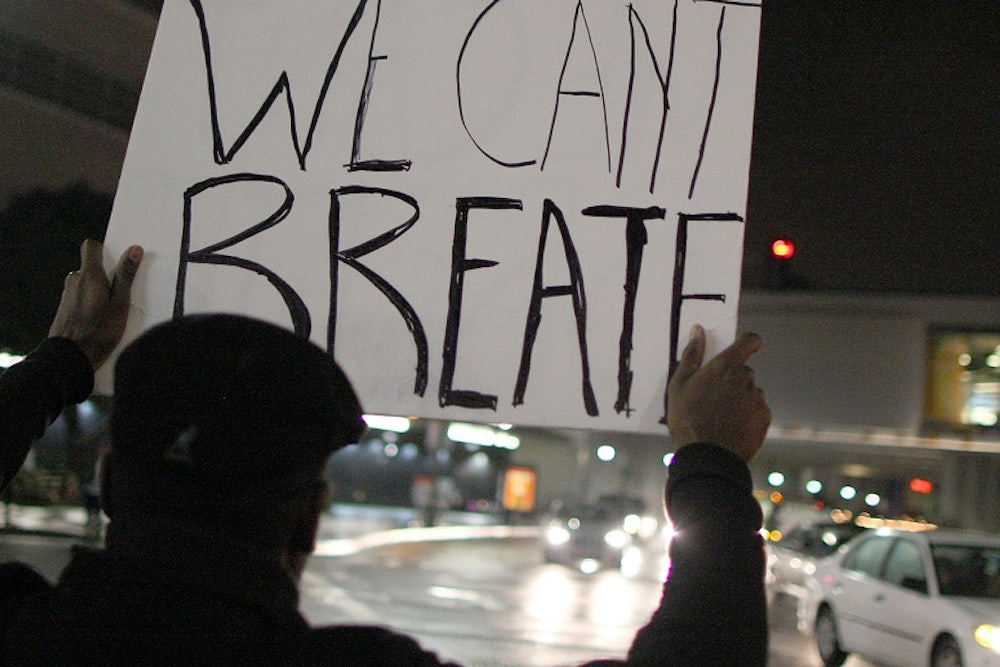The description of events is sadly familiar. A white cop kills an unarmed black man. A grand jury, after hearing all the evidence from a prosecutor, declines to indict the officer. Protesters take to the streets demanding justice. No, this isn’t the shooting death of Michael Brown in Ferguson, Missouri. It’s the death of Eric Garner in New York City—and the details surrounding it are even more appalling.
Unlike in Ferguson, we have video evidence of Garner’s death. The 43-year-old black man was illegally selling cigarettes on the underground market when multiple police officers approached him to place him under arrest. Garner objected, telling the officers he wasn’t doing anything wrong. As Garner continued talking, officer Daniel Pantaleo put him in a chokehold—which is against NYPD rules—and dragged him to the ground as three other cops leaned on top of him and attempted to cuff him. Initially, Garner resisted, although not in a threatening manner. But after he was brought to the ground, that resistance ended. Despite that, Pantaleo then held Garner’s head against the pavement as Garner yelled multiple times that he couldn’t breathe. Soon after, Garner, who had asthma, died.
Warning: Graphic video footage.
This happened on July 17. In August, Staten Island’s District Attorney Daniel Donovan Jr. convened a grand jury to determine whether Pantaleo should be indicted. On Wednesday, they declined to indict him.
Liberals and conservatives alike were outraged by the outcome. At the Federalist, Sean Davis wrote, “It defies reason. It makes no sense.” Some conservatives even said that the case required an investigation by the Department of Justice. (The DOJ did, in fact, announce that it was investigating the case later Wednesday evening.) Liberals were equally appalled at the non-indictment.
Why do the left and right agree that officer Pantaleo should have faced criminal charges but disagree about the proper consequences for Officer Darren Wilson—the man who killed Michael Brown? A major reason is the video evidence. The facts are not up for dispute in the death of Garner as they were in Brown’s death. But that’s not the only reason. The hyper-partisan reaction to the events in Ferguson—which reflected very real differences about the role of race in America—masked the fact that the left and right both see problems with excessive force by police and a criminal justice system unable to hold them to account. “One hurdle to indicting Wilson (besides the evidence) was a perverse Missouri law,” wrote the Washington Examiner’s Timothy Carney on November 26. “Missouri law explicitly allows police to use violent force — to shoot people — if they believe they need to shoot in order to arrest someone they believe committed a felony.”
Figuring out what to do next is no simple matter. How should we reform our laws and criminal justice system so that the officer Pantaleos of the world don’t get a free pass? Better yet, how can we implement reforms so that the Michael Browns and Eric Garners of the world don’t end up dead in the first place? Any policy solutions are bound to require tradeoffs, and they won’t easy to make. “We can increase the training, the pay, and the number of police officers—while tightening the rules and regulations for when they are permitted to use force,” my colleague Yishai Schwartz wrote recently. “It will probably mean that some innocent cops will go to prison, and it may well mean more crime.”
But the fact is the current system isn’t working, and everyone knows it. The hard part is fixing it. Maybe now, we can finally start doing that.
—Danny Vinik
Top articles on the Eric Garner case:
NY Daily News: Harry Siegel writes an emotional reaction to hearing the grand jury’s decision. Also, check out the NYDN’s front page today: “We Can’t Breathe.”
New York Times: A strong editorial demands that the non-indictment not be the end of the case.
Hot Air: Noah Rothman takes a look at what areas we must address going forward.
BuzzFeed: Adam Serwer explains why grand juries so rarely punish cops when they kill, particularly when they kill black Americans.
Slate: Look at images from the protests in New York City last night.
Washington Post: The NYPD banned chokeholds 20 years ago but it still receives more than 100 complaints a year about them. Roberto Ferdman explains.
News from Wednesday:
DEATH PENALTY: A Texas prison inmate with schizophrenia who was scheduled to be executed had his execution halted because his attorneys believe he is too mentally ill for capital punishment. (Michael Graczyk, Associated Press)
EBOLA: An American who has been working in healthcare in West Africa is being flown back to the US to be tested for Ebola. (Mike Stobbe, Associated Press)
Articles we’re reading:
In defense of Millennials: You've heard that young Americans aren't saving enough for retirement. It's not because they are lazy, or don't want to save. These charts show how their real wages have collapsed. (Derek Thompson, The Atlantic)
The new sticker shock: Andrew Sprung explains why some families find themselves paying more for Obamacare coverage next year, even as overall premiums are barely rising or even on the decline. (Healthinsurance.org)
How the Right radicalizes itself: Paul Waldman thinks there is a "cycle of Republican radicalization" in which conservative voters and leaders keep pushing one another further and further to the right. (American Prospect)
What we’re watching:
The Eric Garner case
At QED:
Elaine Teng and our new producer Adam Peck show just how abysmal American maternity policies are. Jonathan Cohn writes about a new report on U.S. health care spending—for a change, it’s not out of control. Rebecca Leber explains why body cams can only go so far to curb police brutality.
Clips compiled by Claire Groden and Naomi Shavin.
